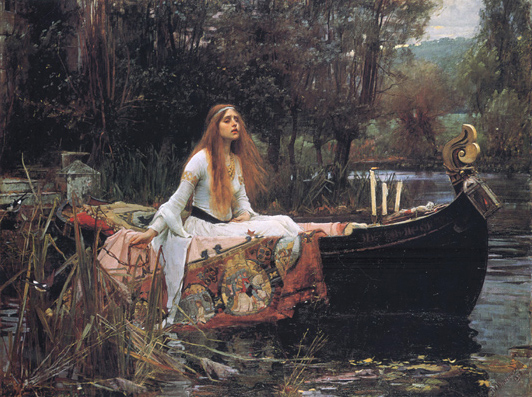

"And at the closing of the day
She loosed the chain, and down she lay;
The broad stream bore her far away,
The Lady of Shalott.Lying, robed in snowy white
That loosely flew to the left and right--
The leaves upon her falling light--
Thro' the noises of the night
She floated down to Camelot:"Alfred, Lord Tennyson, The Lady of Shalott (1842)
In this rendition of Tennyson's poem, John William Waterhouse (1849-1917) pictures the Lady of Shalott having just left her island, the stone stairs visible behind her, the loosening chain still in her hand. Rather than the mysterious and powerful figure portrayed by Hunt, she is a sorrowful maiden dressed in virginal white, which, like the crucifix and rosary next to the candles, suggest her spirituality. And, like the candles, only one of which still is lit, her life soon will be snuffed out, its sensuality, suggested by her red lips, long flowing hair, and low-slung girdle, unfulfilled. The tapestry that drags in the water is one that she wove on her loom and, in the two roundels that are visible, depicts the lady, herself, and Sir Lancelot, the cause both of her destruction and, in his affair with Queen Guinevere, that of Camelot itself. At the left margin of the canvas are two swallows, which, in their reappearance every spring, signify resurrection, just as the fallen leaf in the lady's lap signals her loss of innocence and impending death.
The Lady of Shalott (1888) is in the Tate Gallery (London).
Reference: J. W. Waterhouse (2002) by Peter Trippi.